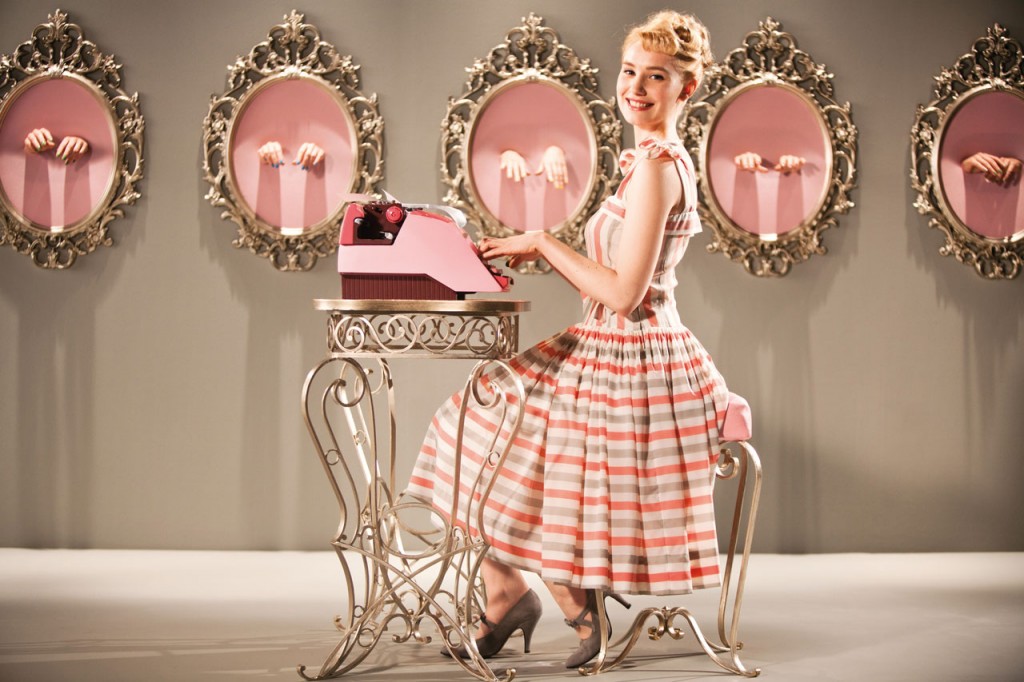POPULAIRE (12A)

Boy meets girl meets typewriter in this thoughtful, witty French take on classic Hollywood romcoms.
PHILLIP FRENCH WRITES AN ENTHUSIASTIC REVIEW IN THE GUARDIAN:
In many ways Populaire is a companion piece to Michel Hazanavicius’s Oscar-winning The Artist in its knowing love for American cinema. It also has the same star, Berenice Bejo (though not here in the leading role), and the same photographer, Guillaume Schiffman, who grew up in the movie business as the son of Suzanne Schiffman, the long-time assistant to François Truffaut, with whom she shared an Oscar-nomination for Day for Night. Where The Artist was a black-and-white homage to the American silent cinema of the 1920s that was shattered by the coming of sound, Populaire is a love letter to the underappreciated Hollywood movies of the 1950s, with a wonderful feeling for the textures of Technicolor.
Populaire begins with the sweet-natured Rose Pamphyle (Déborah François) taking a typewriter from the window of her father’s grocery shop in a small Normandy town and typing her name with two fingers on a scrap of paper. Then, after animated credit titles in the jaunty 1950s graphic style, the film cuts to 1958 as Rose heads confidently to a larger Norman town, Lisieux, where St Therese once lived as a Carmelite nun. Off to make her way in the world, she joins a queue of young women eager to work for self-consciously handsome Louis Echard (Romain Duris), head of a small provincial insurance company. Although she’s put down by the more confident city girls and is clearly inexperienced and accident-prone, she gets the job because she reveals her skill as a two-finger typist. Louis is a preening male chauvinist in a three-piece suit. He sports a tie pin and is never without a cigarette. When Rose asks him not to smoke in the office, he tells her he’ll give up when they pass a law banning such things. The characters are blissfully unaware of or can only faintly guess at a future without tobacco, or a silent workplace where the chattering of typewriters will be replaced by people poring over silent screens. The movie is about social change in an innocent world, about the emergence of affluence and the consumer society. Louis, a gifted runner and boxer in his youth who never became an adult champion or commanded the respect of his gruff father, sees in Rose the opportunity to coach a winner in the unlikely sport of competitive typing, which the movie makes both funny and rather exciting. The film thereafter becomes the story of their professional relationship and of the troubled course their love takes. As both gain confidence, they make different demands upon each other on the rocky road from the local contest to the big time, culminating in the world speed typing championship in New York, where the New World will be challenged by Old Europe. Rose resembles those determined young women of 1950s Hollywood, positive, ambitious but tender-hearted: Doris Day, Debbie Reynolds, Maggie McNamara, Audrey Hepburn and the heroines who came as threesomes in How to Marry a Millionaire, Three Coins in the Fountain and Come Fly With Me. The hairdos and clothes are slightly stylised but never parodied, though at one point Rose manages to have simultaneously a ponytail, a fringe and her hair piled on top. Louis is a cross between France’s Louis Jourdan and Sunset Strip’s Rock Hudson, and his best friend (who’s married to his old flame) is an American called Bob Taylor played by Shaun Benson. Louis is haunted by his experiences in the Resistance. The jaunty Bob met his French wife after dropping on to her parents’ house as a paratrooper on D-Day, 6 June 1944, and Benson was evidently chosen for the role because of his strong resemblance to Gene Kelly, who appeared briefly in Les demoiselles de Rochefort, Jacques Demy’s 1960s tribute to the MGM musical. The particular look of Populaire derives from a close study of the movies made in the 50s by Vincente Minnelli at MGM and Douglas Sirk at Universal, in which much of the meaning is found in their colour schemes. Most of this is attractively playful. At one point, however, an allusion to a specific 1958 film has a real seriousness. Towards the end of The Artist, Hazanavicius uses a minute or so of Bernard Herrmann’s music from Vertigo to underline the fallen hero’s poignant sense of loss. Roinsard also turns to Vertigo by restaging in a Parisian hotel bedroom the scene in which a garish neon sign from outside the window illuminates the moment when James Stewart faces the transformed, recreated Kim Novak. The use of colour and the slight rescoring of a Herrmann theme provide a perfect match for this key Hitchcock sequence and draw into Populaire a host of powerful emotional associations. This is a film that will appeal to cinema buffs who take delight in spotting evocations of other movies, an influential device inviting the audience’s complicity that became a commonplace of moviemaking and moviegoing as popularised by the French New Wave in the early 1960s. It is, however, far from being a cold, calculated picture. Lighthearted it is for the most part and slight. But it’s also thoughtful, amusing and touching. There’s a generosity and kindness underlying the smooth surface and a sense of sadness, of loss, about a past that can be recaptured as style but never recovered as reality. POPULAIRE (12A) 111 mins Fr 2012 (subtitles)Tuesday 12th November 7.30 pm
http://www.theguardian.com/film/2013/jun/02/populaire-film-review-philip-french
Read Phillip French’s review in full (again)
http://www.theguardian.com/film/video/2013/may/28/populaire-berenice-bejo-clip
Watch the wonderful Berenice Bejo (The Artist) in this short film clip
